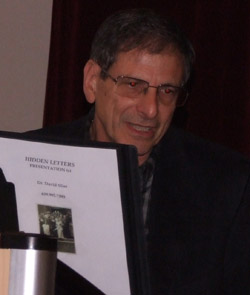
By Donald H. Harrison

SAN DIEGO — An intimate gathering of Navy officers, Holocaust survivors and an offical from the Los Angeles consulate of the Netherlands commemmorated the Holocaust at Naval Medical Center San Diego on Friday, April 13,with personal remembrances of Dutch and Polish victims.
Held in the main auditorium of what also is known as Balboa Naval Hospital, the commemoration featured a speech by David Slier, a clinical psychologist at the Navy Medical Center whose cousin Deborah Slier is a coauthor with her husband Ian Shine of Hidden Letters. Additional presentations were made by Benjamin Midler, a Holocaust Survivor from Bialystok, Poland; and Leo Roos, who hid with his mother in the Netherlands during the Holocaust.
Each told stories of perserverance and survival in the face of Nazi barbarism. Slier and Roos also emphasized the role played by Righteous Gentiles in the Netherlands, who opposed Nazi persecution of the Jews, sometimes at the cost of their lives.
Slier said citizens in the Netherlands protested the imposition of Nazi laws with general strikes; Cardinal Johannes de Jong forbade Catholics to join Nazi organizations, and Carmelite schools refused to expel their Jewish students. When Judge L.E. Visser was dismissed as president of the Supreme Court in Netherlands because he was Jewish, he publicly spoke out against the Nazi regime in every way he could. Further, said Slier, the Resistance was unceasing in its efforts to destroy the Central Registry in Amsterdam, to make the use of counterfeit passports and papers easier for Jews and members of the Resistance.
Nevertheless, 80 percent of the Jews in the Netherlands perished at the hands of the Nazis, many of them at the Westerbork Concentration Camp in northeastern Netherlands, and even more at the Sobibor Concentration Camp in Poland. In 1943, Dutch Jews were among the 300 prisoners who escaped from Sobibor, which later was destroyed and planted over by the Nazis.
“My cousin Flip Slier is a little over one two hundred thousandths part of the ashes at Sobibor, but he lives on in his letters that were hidden for 55 years,” Slier said. A best friend named Karel and others were “working class Catholics who followed the commandment given to Moses on Sinai, ‘Thou shalt love thy neighbor even as thyself’;’ thus Karl visited Flip once a week in camp–an 80-mile walk, each way,” he related.
In recounting the Holocaust events of Holland, Slier wove through his narrative the story of the extended Slier family, most of whom perished in the Shoah.

Roos remembered hiding as a child on a farm owned by members of the Dutch Resistance. As alluring as a certain haystack was in the barn, he was ordered never to jump or play on it. Later on, he found out why, it was stuffed with guns and ammunition.
Dutch people at nearby farms soon figured out that a Jewish family was being hidden at that particular farm, he said, “but no one gave us away.”
Like Slier’s family, most of the Roos family also perished at Sobibor, said the speaker who traveled 120 miles from the Los Angeles area to participate in the commemoration.
On one occasion, he recalled, he and others had been captured by Nazi SS men, but two teenagers released them, telling them to run away — proof, he said, that not everything was black nor white.
Midler, today a San Diego resident, has told of his life in the memoir, “The Life of a Child Survivor From Bialystock, Poland.” He was 13 when the Nazis marched in 1939 into Bialystock, which was then a “citadelof Jewish culture.” Under the pact between Hitler of Nazi Germany and Stalin of Communist Russia, the city passed to Russian control until the pact unraveled and the Nazis again invaded in 1941.
Thereafter the main synagogue was burned with perhaps 1,000 people inside, Midler said, and thereafter another 5,000 were rounded up and executed. He avoided several roundups and liquidations, but eventually wassent to a series of six concentration camps, ending up the only survivor of his entire family. The fact that he was a skillful tailor helped him get selected for work details rather than for death in the gas chambers.
Midler said he believed he survived the Holocaust because it was intended that he be a witness.
After liberation he made his way to Israel, where he fought in the War of Independence, lived on a moshav, and eventually immigrated to the United States.
The late-morning program was emceed by Captain Robert McClanahan, the regional chaplain for Navy Medicine West, with guests given an official welcome by Capt. Mark Kobelja, the medical facility’s deputy commander, who commented that history is doomed to be repeated if we don’t learn from it.
McClanahan, a Baptist, offered a prayer in behalf of the Jews asking God to “bring a new blessing of favor on your Chosen People.”
Among the guests was Ans M. Egthuysen, representing the consulate of Netherlands’ “World War II Victims of Persecution Department,” which is based in Los Angeles. Over the years, The Netherlands has enacted a variety of laws to assist people who were victimized during World War II, including not only the Jews under Nazi German occupation but also Dutch-ruled Indonesians who were severely mistreated by the Japanese.
*
Harrison is editor of San Diego Jewish World. He may be contacted at donald.harrison@sdjewishworld.com